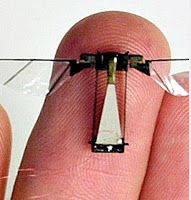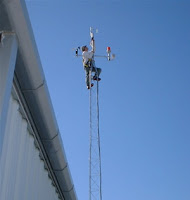 |
| Source |
Michael Edwards
Activist Post
In the span of just three years, we have seen drone surveillance become openly operational on American soil.
In 2007, Texas reporters first filmed a predator drone test being conducted by the local police department in tandem with Homeland Security. And in 2009, it was revealed that an operation was underway to use predator drones inland over major cities, far from “border control” functions. This year it has been announced that not only will drone operations fly over the Mexican border, but the United States and Canada are partnering to cover 900 miles of the northern border as well.
Now that the precedent has been set to employ drones over non-combat areas, the military is further revealing the technology of miniaturization that they currently have at their disposal. As drone expert, P.W. Singer said, “At this point, it doesn’t really matter if you are against the technology, because it’s coming.” According to Singer, “The miniaturization of drones is where it really gets interesting. You can use these things anywhere, put them anyplace, and the target will never even know they’re being watched.”
So what exactly is on the horizon?
The Defense Advanced Research Projects Agency (DARPA) funds military tech development through the private sector with defense contractors such as Lockheed Martin, Boeing, and Honeywell. It was Honeywell that introduced the T-Hawk micro drone — now purchased by Miami-Dade county for use in the metro area — which weighs all of 16 pounds and can fly in any direction. However, this is not so “micro” compared to the latest spy drone to be revealed: the Nano Hummingbird, produced by AeroVironment. The video below illustrates the capabilities of this 19g vehicle:
This mimicking of nature heralds a range of science fiction nightmare scenarios, but the name of this vehicle, “nano”, is what should spark a red alert. Because, in fact, DARPA and their contractors are working on true nano surveillance that will have biological components . . . and applications. Here are some surveillance and detection concepts already in operation, or under development (keeping in mind that what is revealed in the public domain is often quite far behind the reality):
- A group of smaller surveillance drones called NAV (nano air vehicles) or MAV (micro air vehicles) already have been commissioned: mapleseed drones; sparrow drones by 2015, dragonfly drones to fly in swarms by 2030, and eventually a housefly drone. And if the reconstruction of nature doesn’t pan out, nature itself can be hijacked using electrical impulses to create cyborg surveillance insects being studied at major universities.
- Nano sensors for use in agriculture that measure crops and environmental conditions.
- Bomb-sniffing plants using rewired DNA to detect explosives and biological agents.
- “Smart Dust” motes that wirelessly transmit data on temperature, light, and movement (this can also be used in currency to track cash).
- Nano-based RFID barcodes that can be embedded into any material for tracking of all products . . . and people.
- Devices to detect molecules, enzymes, proteins and genetic markers — opening up the door for race-specific bioweapons, as mentioned in the Project For a New American Century’s policy paper Rebuilding America’s Defenses.
There are countless ways that we are already tracked in our daily lives, which has acclimatized us to the next steps underway. We know that the military has a desire to track large groups of people in real time. The Gorgon Stare program is currently undergoing some operational difficulties, but the political will is there to continuously expand surveillance of large populations abroad in order to keep us safe at home in the never-ending War on Terror.
 |
|
Strategically mounted sensors and a communications
network are the heart of SensorNet.
|
By 2006, Oak Ridge announced that they planned to turn Fort Bragg military base into a prototype for America’s future cities. According to Department of Energy researcher, Bryan Gorman, “Any sensor can talk to any application. Just like with the Internet or with telephone systems, it doesn’t matter what kind of computer or telephone you have, where you are or what application you’re running. The system just works.”
There is even a proprietary social network that has been designed to provide online access and collaboration. SensorNet has since morphed into an even more comprehensive system “to integrate safety and security measures . . . into the transportation system,” which includes concerns surrounding transportation and commerce in the “political, economic, or environmental” arenas.
It is here that the full scope of surveillance integration can be seen as a management strategy that merges legislation, federal inspection systems, international standards, security threat assessments, and the latest in nanotechnology. Just one example is their discussion of “highway sorting” systems and screening, which begins on page 15 in the previous link; it must be read to be believed. As an aside: the Senior Research Scientist and Senior Program Manager who co-authored the paper linked above is Robert K. Abercrombie, Ph.D. who has a decided interest in cybersecurity.
To see where the transportation component of the surveillance grid is heading over the near term, the ITS Strategic Research Plan 2010-2014 is a good indication.
The Promise of Total Integration
February 4, 2011 brought the release of the National Nanotechnology Initiative 2011 Strategic Plan. This 60-page must-read document lays out a projected future “to understand and control matter” for the management of every facet of human life within the surveillance matrix of environment, health and safety. Here is the short-list of the 25 participating Federal agencies and samples of their stated applications:
- Department of Defense (persistent surveillance)
- Intelligence Community (unmanned aircraft)
- Department of Energy (solving energy and climate change challenges)
- Department of Homeland Security (low-cost sensor platforms)
- Department of Justice (applicable to criminal justice needs)
- Department of Transportation (modifying or coordinating travel behavior)
- Environmental Protection Agency (environmental sensing, transformational capabilities)
- Food and Drug Administration (biological systems and effects on human health)
- National Institute of Food and Agriculture (global food security)
- National Institutes of Health (precise control to achieve predictable outcomes)
- Department of the Treasury (improved governance, implementing economic sanctions)
- National Science Foundation (education and societal dimensions)
The promise of integrating technology in a way that will benefit human knowledge and society already has been re-directed toward military applications for decades. It has manifested in the out-of-control military-industrial complex that has engaged America abroad in costly wars and destabilization campaigns. However, the fallout from this misappropriation of technology is beginning to take its toll on America in the form of militarized police and the monitoring of everyday Americans. How much longer before the full spectrum of military sci-tech, including what we cannot even see, is unleashed upon an American people willing to accept total control to be safe? Has it happened already? Or, more importantly, how long before Americans come to the realization that when the construction of this surveillance prison has been completed — when the door is locked, and the key thrown away — it ultimately will have been our own money that was used to build it.
Additional sources for this article:
- Little Brother is Watching You: The future of surveillance is small, very small
- On Race-Targetable Biological Weaponry
- It’s a Bird, It’s a Spy, It’s Both
- The plan for smaller, faster, deadlier UAVs
RELATED ARTICLES:
DNA “Genetic Patdown” Introduced to Airports by DHS
Is Military Spending Saving or Enslaving?
Police and Military Working Together to Oppress Americans


Be the first to comment on "How Close Are We to a Nano-based Surveillance State?"